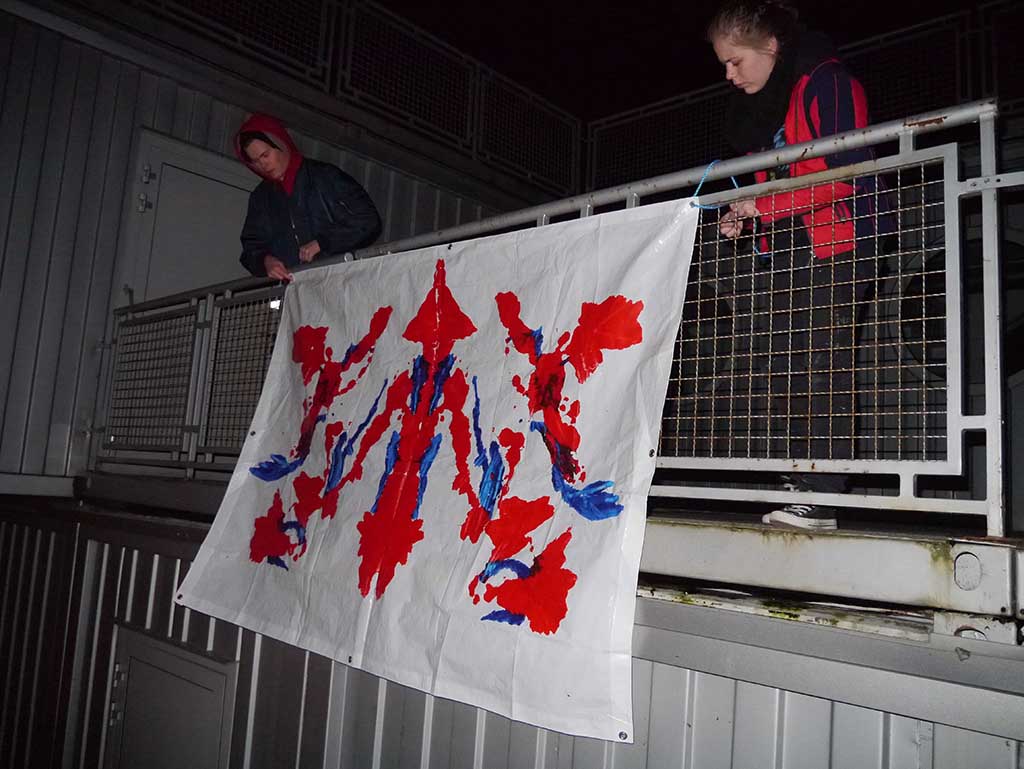Heather Jones: You just got back from a residency in Rotterdam – welcome back! Maybe we can start with the project that you just recently presented? What took you to Rotterdam?
Siri Borge: It was a paid residency with a gallery called V2 Lab for Unstable Media. It’s called Summer Sessions and it’s supposed to help emerging artists financially and through mentoring. There were seven other participants working at the same time. It was wonderful to have a paid residency – I’ve never been able to do a production that was that expensive before. But it was kind of weird because I was working with MRI scans, so it’s a different kind of media. It’s different than photography, it’s different than video, but it’s not new. It’s been around since the 70’s. I was working with a lot more traditional techniques while other artists were working with apps, digital tech, and post-internet concepts. And I was working with feminism and other concepts outside of technology as well. The media was a means to an end.
HJ: At the end there was a group exhibition of all the participants. You presented a single installation. Can you talk a bit more about the final work?
SB: Yes. It was 49 scans – I had 24 hanging and I had 5 light boxes with 5 scans layered on top of each other. I made these small wooden (40X40cm) frames and stacked them together, with 5 cm in between. And it made this really cool effect. It’s like animation when you have all of these layers. And all of this was also very visually abstract because they’re cross sections. You don’t immediately recognize what you’re looking at.
The installation was titled Undiscovered Territory. It has to do with all the issues that we have as females with our vaginas, with that whole area – everything from mutilation to giving birth and having problems, dying in childbirth, cramps, pms…
HJ: Were you also then addressing the issue of taboo? That all of these issues exist but aren’t supposed to be openly discussed?
SB: Yes. Along with the exhibition I had to present and defend my work. One of the reasons that the MRIs were important for this piece is because there was a researcher, Helen O’Connell, who researched the clitoris using MRI scans. And this is how she discovered the true size of the clitoris which everyone thought was the size of the tip of your pinky finger. But then it turns out to be a lot bigger and goes a lot deeper, and that the vaginal orgasm is actually a clitoral orgasm. The organ is actually so big and the nerves extend much farther than we thought before. The study was published in 1998, and of course it was under-financed and this was the same year that Viagra came out on the market which was just wow… it was so supported in the public.
So working with this idea, you can actually see my clitoris going all the way through the scans. You can see completely all the details of my organs. And it’s nice, it starts with a picture of me where just a little bit of the skin is away and you can still see my panties. And then my body gets even more undressed as you go further in.
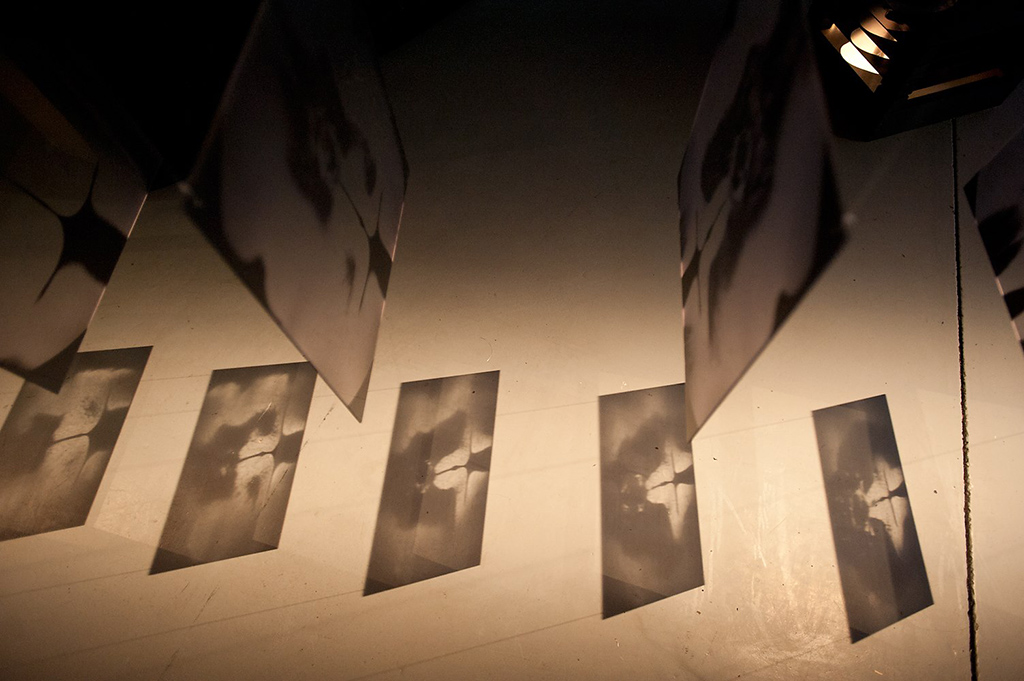
HJ: Through layers of the body basically. Was that vulnerable for you? You’re essentially stripping yourself bare.
SB: Yes, the whole show was extremely vulnerable. Definitely. I made a point of letting people know the scans were of my body, the reason is being this distance we can have to people as objects. Also in a medical setting you can be objectified so easily. And I think that by using myself and doing something personal, it raises the possibility of having more connection with the piece itself. Also the fact that I, as the artist, was present at the exhibition, people could easily make that connection. And the prints were also hung at the same height as my body. So I would stand in front of the piece and talk about it and it was really obvious. Of course some people didn’t quite get it, some did …
HJ: Right. What was the reaction? What kind of feedback did you receive?
SB: I actually got a really great question from the audience. One woman said, “Well how big is the clit?” And I think I said something like “Well you know, size doesn’t matter, but I think mine is really big.” And then there were other people that asked me how I found these studies, how I came to work with this research, with these issues, which was also a really weird question. Because I’m interested in this? Because I’m a female? It was really odd. And another man came up to me afterwards and he said, “You said out loud words that should only be whispered.” But in a way that he was impressed that I did it.
“You said out loud words that should only be whispered!”
HJ: More practically speaking, I want to ask you about process. Are MRI scans and photography a media you have used before?
SB: I work with everything basically. Whatever I feel like, although it usually ends up in an installation. I usually think “more is more!” Some of my work is a little bit extreme. I like that kind of aesthetic that’s a little bit off. I think this is the one piece that I’ve done where it was important that it was aesthetically beautiful. It’s the first time that I’ve thought to myself that this is something that I want to be attractive. I felt the vagina deserved a little time in the spotlight, but it also had to do with my own experience of seeing the scans for the first time. Because even though I am an independent, confident woman, of course there are things that I would like to change. I’m critical. But the first time I saw this scan, I think that was the first time I looked at myself and thought, “This is so beautiful.” I saw myself, and saw how fragile I am, and how much actually goes into the body to make it all work – all the building blocks. I had this existential moment of realizing that I was actually a human being. Until then I think it was just a theory to me. It was just this feeling of, it’s cheesy to say it, but loving yourself, of appreciation. I was very surprised, and very happy.
HJ: If this is the first work that you wanted to be aesthetically attractive, what has your past work been like? And dealt with conceptually? This was your most recent project, maybe we can move back now in time. Have issues of feminism, gender, and sexuality continually been a focus of your work?
SB: It’s been very accidental earlier. There are a lot of artists that are really good at making things neat, and cohesive. And I’m not that at all.
I did a performance earlier in Sokndal called Vessel Landing Conquest. This was a political performance that I did after being in conversation with the people that lived there and realizing that there is an ongoing issue with the mining industry becoming so efficient. A lot of people are losing their jobs and way of life. There is a sand deposit here from the 60s where the performance took place, and it’s actually really small compared to the newer mining area area. I took a bus in to see the new sand deposit and it’s a fucking desert! It’s huge! They’re buying up land, mining it, and leaving behind the waste behind, which is full of nickel and pollutes the groundwater.
I found out about it because Maiken Stene organized the residency and tour and I was able to talk to this geologist so this idea was just something that occurred while I was there. The title is Vessel Landing Conquest, and Titania, the mining company, is an American company. So the money goes out of the country. They buy up the land and Norway doesn’t have the other processes necessary to turn the raw minerals into something else, so they ship it out.
The company does employ people but not that many. When I was there I was told they were making even more cutbacks in the coming months. And the thing about Sokndal is that the stones and landscape are a little bit purple. It’s really beautiful. And it turns out that the kind of stone that makes up a lot of the mountain is only found in two other places. One of them is in Canada and one is on the moon. I was just seeing this American company coming over in the 60’s and taking over, much like landing on the moon in the same era. So I decided to do a performance that was very site specific and very much for the local people. I had a moon landing there where I arrived and planted the American flag.
As I mentioned, there was a residency as well. Geir Haraldseth recommended me. I was the only local other than Maiken. It was nice to be recommended and really great to be part of it.
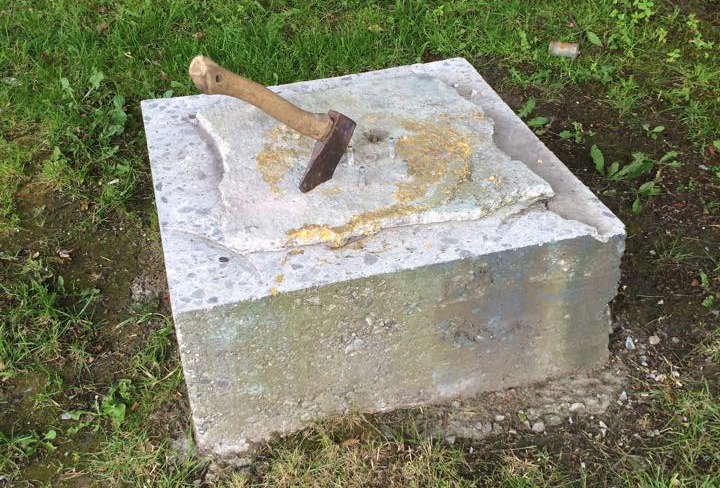
HJ: Going back to some of your other previous works, I want to talk about Physical Navigation, Transplanting Pit, at the Stavanger Art Museum, but first let’s discuss Occupy Landscape, as I understand it is kind of a lead-up to the project with the museum. Can you talk a bit about Occupy Landscape, and what you did and how this next project sprang from there?
SB: Yes. Occupy Landscape was the young artists’ contribution to the debate regarding the sale of the Hepworth sculpture. Instead of joining the debate, and feeling like we wouldn’t be heard anyway – we felt like our voices would just be drowned in a lot of bullshit – instead of that we thought that using what we had, using art as communication, would be more effective. And we wanted to show something new springing out of something old. For me, this was the strongest way of expressing our opinions. And also it happened without the Kunsthall knowing about it. We didn’t ask. We just did it. And it was great! It was 17 works. We started out with 1 every week, and then took a break for a few months during the winter, and then started up again and just took at our own pace.
HJ: I know you were one of the organizers, but you also contributed an artwork to this series. What was that?
SB: I put an axe into the stone, the pedestal where the sculpture had stood, which was for me a comment on the debates regarding finances in political culture, and how I, and others, feel like we don’t have a say about how funding is being cut. Axing. And also the way that artists’ feel perhaps after a work is finished, when you’re done with something, you just kind of throw it down. So this was the last one in the series. It was also like putting a final end to it. But also it has the sword in the stone reference. Which was really funny because I installed it several times and I cemented that fucker down, but people came and always pulled it up. It was a kind of call to action.
HJ: This looks very different to me than the work from the Kunstmuseum. So how did the project at the Kunstmuseum come out of this?
SB: Occupy Landscape was my initiative and I was kind of curating it in collaboration with Bente Ånestad, so the whole project for me was something that feels like a work of art in itself, not curating. More like one big project.
The museum approached me and asked me if I wanted to do Occupy Landscape there. And I was like, “Well you can’t really do Occupy Landscape there because you don’t have that thing, that pedestal, that controversy. But if you want me to curate something or have a project, I can do that.” They agreed and gave me a small amount of funding. So I asked Hans Edward Hammonds and Kerstin Juhlin from Bergen. We’re very different people so I wanted to see what would happen putting us together. We made this big vagina out of dirt. Or vulva I guess. It’s called Easy Physical Navigation, Transplanting Pit because we were taking into consideration the surrounding area where they are building the tunnel. We went into the tunnel and made sound recordings of the explosions. Then we made a hole in the ground and from the dirt that was displaced we got the fundament for this sculpture. We rented speakers and placed them into the ground and they were playing the sound of the explosions underground. So it turned into this strong vibration – you could hear it and you could feel it. We actually blew out a speaker one hour before the opening.
But also at this point Marit Victoria Wulff Andreassen was having the Through the Woods exhibition on the inside of the museum. She does a lot of illustrations of puberty. I was there for a meeting and I really had no clue what I wanted to do. I walked in and saw the exhibition. And I was like “Are you fucking kidding me? There is no hair on these vaginas! They are completely bare.” Like porn from the 90s. So for my project I thought “Ok, I’m going to make a big, hairy, natural cunt outside.”
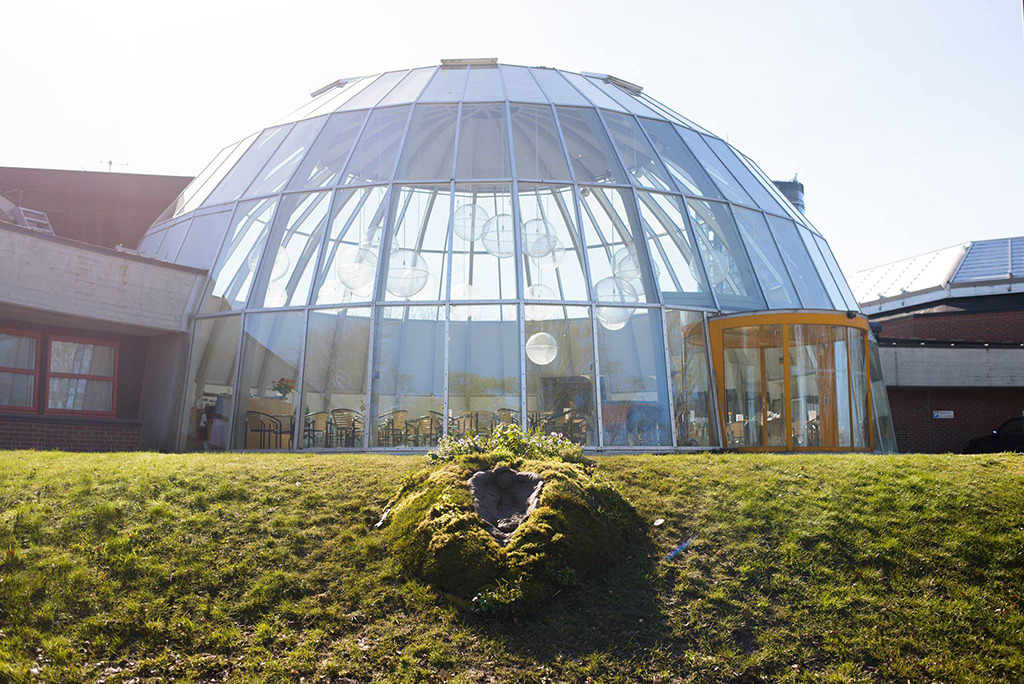
HJ: So your project was actually a kind of protest against what was on view inside the museum? Can I ask you what the reception was?
SB: I’m honestly not sure if people got the gesture. Other than oh well there’s a big cunt outside Stavanger Kunstmuseum. It was installed for 5 days… and quick side note: all the plants planted here are edible. This is clay that we found in the area and molded by hand. But it’s not fired, so if it rains it rains. But I think all of us were really happy with it. You know it’s kind of difficult in a city like this to say I’m protesting what’s going on inside by putting an artwork outside. But that’s how I voice my opinions, by what I make. We wanted to give an alternative to what was going inside. It’s hairy, it’s fuzzy. I feel like there is so much commercial bullshit out there in the world, and as artists we have some kind of duty to show something else, something that has some fucking truth in it. So that’s what we were trying to do.
“I feel like there is so much commercial bullshit out there in the world, and as artists we have some kind of duty to show something else, something that has some fucking truth in it.”
HJ: But also you’re making a vagina in the earth, so there does seem to be some kind of environmental context. Earth as female. Earth and destruction, rape of natural resources, etc.
SB: Yes we were talking about this when we were walking around in in the area. Easy Physical Navigation is about the tunnel, and Transplanting Pit is taking that tunnel and making this other one. And we were talking about the surrounding nature the sort of metaphorical rape of the area. The animals around there were very affected by the explosions for example. The forest there is where the birds nest at night. I’ve seen it myself several times where thousands of crows come to nest and then there’s an explosion and they all take flight. So yes, the piece was very complex. There was a lot happening.
HJ: Circling back to this idea of commercial bullshit vs. truth, you did another performance fairly recently in Bergen dealing more straightforwardly with these issues. Can you describe that project?
SB: In December of 2015, Maya Økland organized the launch of Political Propoganda with Petr Pavlensky in Bergen at Landmark, sponsored by Fritt Ord. Piotr Pavlensky and Oksana Shalygina have this magazine called Political Propoganda, and they made a feminist version that Maya curated and had translated into English. Oksana, the partner of Pavlensky, came as he was in jail at the time and had a book launch and they showed a video work of Pavlensky, they had a Q&A, and I made this performance. It was a really big deal for me because I am a huge fan of Petr Pavlensky. (In 2013 I rolled myself in construction fencing as an homage to his barbwire piece.)
So anyway, Maya asked me to do a performance at the event, and I did the most humiliating performance I’ve ever done in my life. I actually cried afterwards. It’s weird that I do performances because I really hate doing them. When everyone is looking at me I feel like my skin is burning, like a witch hit by sunlight or something. For this performance, I made a very simple installation with a soundtrack playing in the background with words that are very commonly used in commercials for female products; like easy, beautiful, smooth, soft, glossy, supple, effortless, etc. I came out and started the performance by waxing my legs…
HJ: Did you actually wax your legs in front of the audience?
SB: Yeah! I did! And I had never done it before – it wasn’t very comfortable. And then I got out of my robe and I started to shave my bikini line, while trying to look seductive and effortless. And this was the whole idea, how sexy everything is on TV, even the process of hair removal. You see people shaving their armpits but there’s no hair there from before?
This is what I was interested in, showing the really uncomfortable part of this process. If you’re standing in the shower, and you’re trying to get that place, it’s so awkward. You’re debating, “why the fuck am I doing this?” So I did this in front of a lot of people. I just wanted to show this a somewhat commercial setting. It cost so much of me because even though I’m a confident woman and artist, I still want to be seen as attractive. And seeing the documentation afterwards was fucking horrible. The pictures that Maya took are gorgeous. I’m so happy about the images, but it was really hard to see.
“It’s very accidental the performance part of my work because I really don’t like doing it. It takes a lot out of me. But then again, so does absolutely every piece of art I make. I feel that if it doesn’t take something from me in the process then it’s not worth making… . In Norwegian we have an expression, Å legga håve lagligt te for hågg, which basically means to put your head on the chopping block. I feel with everything that I do. “
HJ: But it seems like the performance was very successful. Difficult for you as the artist, what a vulnerable position to have put yourself in, but successful conceptually.
SB: Yes it was. I was upset that people didn’t laugh though! I also couldn’t really see people because of the light, although the audience was very close and intimate, so I wasn’t sure of the reception. And then after the performance someone thanked me. That had never happened to me before. It was really great. My old professor was also there, and he said that it looked like an extremely difficult piece, and he hugged me. And Maya also said she was happy with the whole evening overall.
HJ: I feel like that’s a question a lot of performance artists ask themselves because you’re performing and you’re doing it for art and you’re playing a role, but it’s also still you. You’re still vulnerable and it’s embarrassing or challenging. It makes me think of Yoko Ono’s Cut Piece, where she sits calmly letting people cut her clothes off. That’s what the piece is about, and yet it doesn’t make it any easier. It still affects you as the performer, right? I think perhaps often the audience doesn’t realize that. Did you study performance in school?
SB: I studied fine art at the academy in Bergen under the Swedish artist Annika Erikson. It’s very accidental the performance part of my work because I really don’t like doing it. It takes a lot out of me. But then again, so does absolutely every piece of art I make. I feel that if it doesn’t take something from me in the process then it’s not worth making. For instance, Occupy Landscape was really difficult because I just moved back and was voicing my opinion so strongly without knowing that many people in town. And of course the debate was really ugly. And that statement was taking sides. It was difficult.
And doing this performance was also very difficult. Working with everything that is political, everything that is social, is difficult. I do quite a lot of research because I’m terrified to get something wrong. I want to be able to have a discussion about the work and really know what I’m talking about. In Norwegian we have an expression “Å legga håve lagligt te for hågg.” Which basically means to put your head on the chopping block. I feel that with everything that I do.
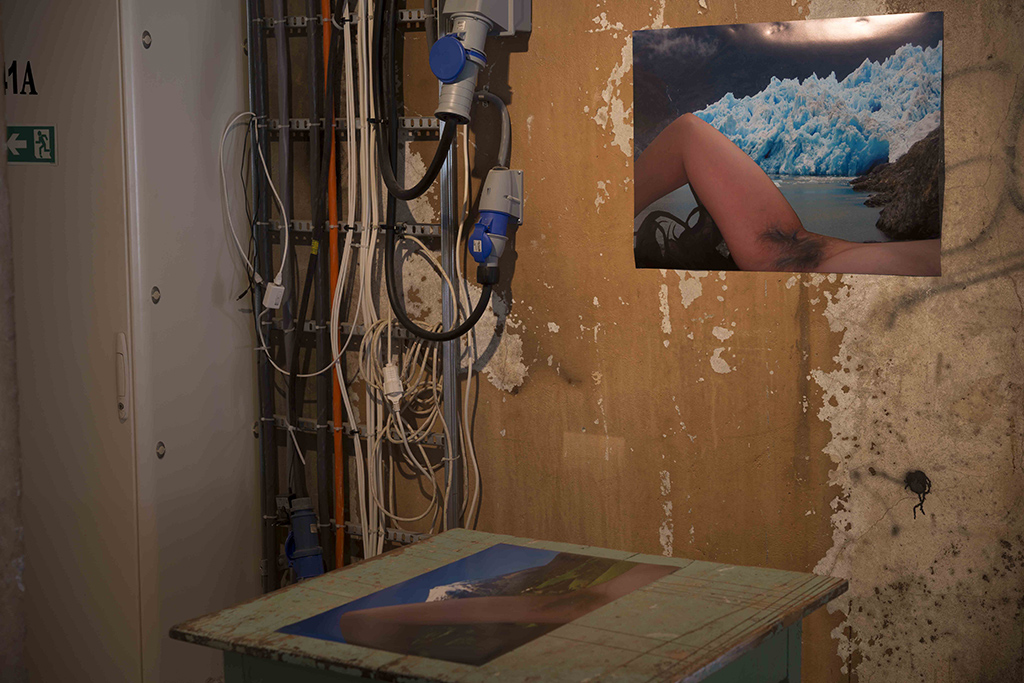
HJ: Do you think this is specifically true of the Norwegian context?
SB: I think it also had to do with competition, and touchy subjects. I was also studying kind of before this new wave of contemporary feminism hit Norway, and I think a lot has happened since then. I was talking a lot about feminism and my work being feminist in school and other students would say “I’m not a feminist, I’m a humanist” and I was like where am I? And then I went to Malmö for 6 months and it was such a relief! People had hairy armpits and were talking about feminism – I was even in a feminist knitting group! It was great! And during that time a lot of things happened politically in Norway that kick-started a lot of feminist politics here in this country. I felt a really big shift. It was absolutely the break that I needed. Being in Sweden where feminism had been going strong for years was encouraging.
My final piece at the academy was called Hårsår, sår hår. When you pull someone’s hair, and it hurts, you say sår because you’re sore. So sår hår. You can even say that about people being fragile or easily offended. And then when you say sår in this context, it means planting something. For my final project I made photo collages of typical screensavers, pretty pictures of sublime landscapes, and I put in my own armpit with hair. I colored each hair the same tone to match the surrounding landscape in the photograph. So it’s blue and icy, or lush and green. And finally finishing school was so good! When I was done it was like someone was holding my arm for three years and I was finally released.
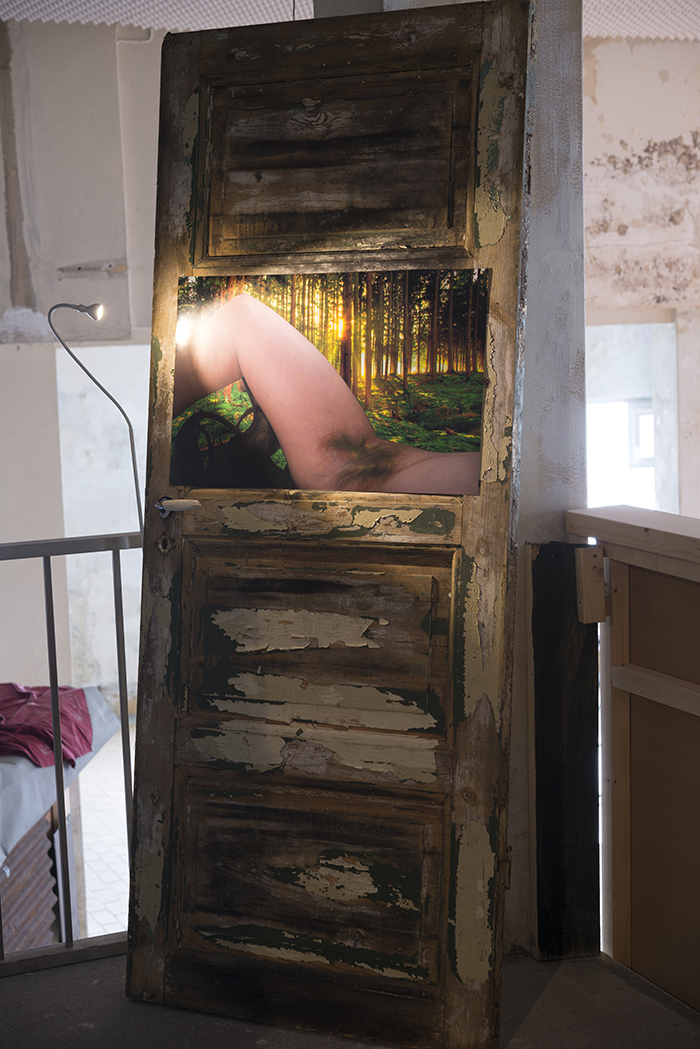
HJ: Can I ask you what you’re doing now? You just got back from Rotterdam, you have a new studio here at Tou Scene. What’s next for you?
SB: I have two things coming up that I’m really excited about. In 2018, I’m doing an exhibition curated by Anna Ihle. The working title is Oil Flow. She saw my work in the show Green is the New Black, my first show in Stavanger in 2013, and invited me to do this next exhibition with her. And the other big thing, and they’re tied together, is I’ll be doing a residency in New Orleans in April and May of 2017 with Delta Workers for two months. Amy Mackie is working together with Delta Workers, curating two projects for me there. Delta Workers has a residency and I was accepted and knew Amy from before. So we decided that we should all work together.
So right now I’m working on funding and support for the project. It’s not a paid residency, because it’s in the US and so I need to supplement funding for production. The working title is Crude Trace, and I’m going to work with crude oil. That is something that I’ve been wanting to do for quite awhile. I’ve worked with Rorschach drawings before, and I want to work with crude oil as ink, as medium. I also want to paint with the crude oil. I’m not much of a painter anymore but I want to experiment with it, to see if I can use oil for something else. Which I think is interesting since the price of oil going down. Can you sell oil as paint? Will that help the economy and give the material a different life?
So I’ll be working with this in New Orleans, but I’m going to start here in Stavanger. New Orleans and Stavanger are related in my mind, which is why I’m excited to work there. New Orleans is in the States but with all of the wooden houses and distinct culture, it’s very different.
HJ: Right. People often refer to it as the most northern Caribbean city. It doesn’t really feel like the US.
SB: Yeah. It has these old historic wooden houses. It’s also a port city. Louisiana is an oil state, and NOLA is having all of these problems with the geographic area because they’re taking all of the oil out of the ground, and there are concerns about cancer, and polluted water of course. And you have Stavanger that is also a port city, wooden-house city, oil city, that has been flourishing for so many years. And right now the economy is going down in Stavanger while it’s going up again in New Orleans. I’m looking at similarities and differences. I think one of the things that makes New Orleans so special is that it’s taken great care of the cultural inheritance. They’ve Americanized it of course, but you have the mix of the Irish and the French and the Caribbean, all this stuff coming together. The music and the food – there’s so much there! And then you have Stavanger that is trying desperately hard to build skyscrapers and fancy, new apartments and tearing down buildings that used to be factories for the canning industry and old houses.
HJ: There’s definitely a sense of trying to preserve history in the US that is uncommon elsewhere, and it might be because we’re such a new country, we’re desperate for a sense of history. And then you come to a much older city and people are knocking it down. It’s a different mentality.
SB: Yeah exactly. It’s something I’m really struggling with, being in Stavanger and seeing the way that our cultural heritage is being treated. So that’s one of the reasons I want to go to New Orleans and do research and work with oil as the starting point of this discussion – the economics and building construction of two cities that are approached in completely different ways. And of course I’m thinking of doing a performance …
Siri Borge (b. Stavanger, Norway, 1985) studied art in Oslo, Bergen and Malmö before returning to Stavanger the spring of 2014, where she since has been based.
Borge’s artistic practice is usually motivated by political subjects, such as feminism, cultural politics and environmental issues. In her latest works, she focuses on the female body, working with its relation to medical science and beauty ideals. Her approach to art is often colored by satire and sarcasm with undertones of activism. Use of media varies from sculptural, photographic and video based elements, often put together in larger installations.
Borge is currently working on several projects in Stavanger including Galleri Artilleri, a limitless project space where public space is the main focus. In addition, Borge has worked as a gallerist and curator at Studio17 for over two years. She is also on the board of the political union for local artists, and has recently published an art critique in the Norwegian magazine Billedkunst.


